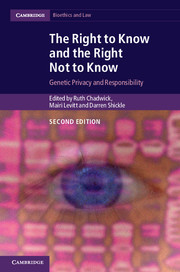Book contents
- Frontmatter
- Contents
- List of contributors
- Acknowledgements
- Introduction
- Part I Philosophical and legal issues
- Part II Issues in genetics
- 4 Biobanks and feedback
- 5 Suspects, victims and others: producing and sharing forensic genetic knowledge
- 6 Empowered by choice?
- 7 DIY genetics: the right to know your own genome
- 8 Genomics, inconvenient truths and accountability
- Part III Emerging issues
- Index
- References
7 - DIY genetics: the right to know your own genome
Published online by Cambridge University Press: 05 September 2014
- Frontmatter
- Contents
- List of contributors
- Acknowledgements
- Introduction
- Part I Philosophical and legal issues
- Part II Issues in genetics
- 4 Biobanks and feedback
- 5 Suspects, victims and others: producing and sharing forensic genetic knowledge
- 6 Empowered by choice?
- 7 DIY genetics: the right to know your own genome
- 8 Genomics, inconvenient truths and accountability
- Part III Emerging issues
- Index
- References
Summary
Introduction
This chapter focuses on one specific area, namely the emergence of genetic and genomic tests offered online. These tests often require test takers to submit no more than their personal and credit card details and a DNA sample (typically a certain amount of saliva). The fact that many of these online services do not require that test takers go through their physician or any other medical professional has earned them the label ‘direct-to-consumer’ (DTC) or ‘do-it-yourself’ (DIY) genetics. These labels, however, are confusing, as most online genetics companies offering health-relevant information do actually require the involvement of a health professional somewhere in the process (for example, test takers may need to order the test via their physician, but can access results directly online). Effy Vayena and I introduced the term ‘beyond-the-clinic’ (BTC) genomics as a label under which the various forms of interactions between service providers, users and medical professionals can be subsumed, and which also accommodates the increasing overlaps between online genetics and the clinic (Prainsack and Vayena 2013; see also Topol 2012; Vorhaus 2010).
It should be noted here that although some arguments presented in this chapter are applicable also to tests for genetic ancestry, the focus of the chapter is on tests that are explicitly health-relevant.
- Type
- Chapter
- Information
- The Right to Know and the Right Not to KnowGenetic Privacy and Responsibility, pp. 100 - 115Publisher: Cambridge University PressPrint publication year: 2014
References
- 6
- Cited by



